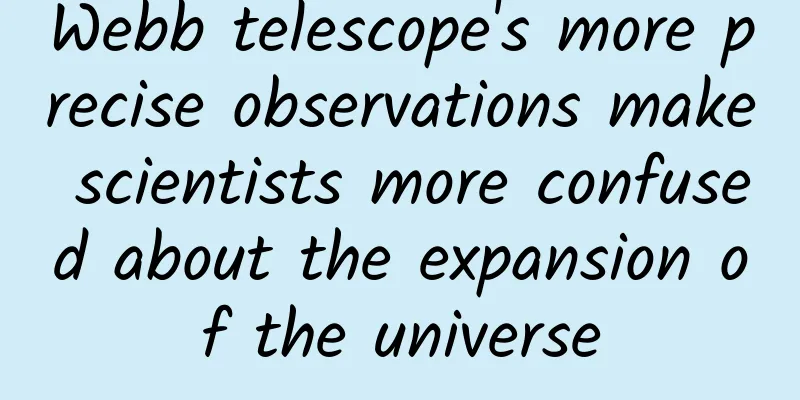Webb telescope's more precise observations make scientists more confused about the expansion of the universe

|
Our universe is expanding, and an important "constant" to measure the expansion rate of the universe is the Hubble constant. There are two methods to calculate the Hubble constant: the "distance ladder method" and the standard cosmological model method. As the measurement accuracy improves, the Hubble constants obtained by the two methods are significantly different. Some people speculate that the backbone instrument of the "distance ladder method" - the Hubble Space Telescope (HST) - produces certain deviations when measuring distant Cepheid variables, making the Hubble constant obtained by this method inaccurate. However, the latest observations by the Webb Space Telescope (JWST) have proved that the HST observations are accurate. Therefore, the Hubble constant problem has not yet been solved. Is there a problem in a certain link in the distance ladder method, or is there a problem with the standard cosmological model? Written by | Wang Shanqin Recently, the team of 2011 Nobel Prize winner Adam Riess (1969-) announced [1]: Observations from the John W. James Webb Space Telescope (JWST) confirmed that the Hubble constant obtained using the "distance ladder method" is indeed inconsistent with the Hubble constant obtained from the standard model of cosmology. The inconsistency between the Hubble constants obtained by the two methods is called "Hubble tension", which can be translated as "Hubble conflict". So, what is the Hubble constant? How is the Hubble constant measured? How does the Hubble conflict arise? And if the Hubble conflict does exist, what would it mean? Hubble constant In 1929, Edwin Hubble (1889–1953) measured the distances of 24 galaxies and compared them with the velocities of 20 of them measured previously by Vesto Slipher (1875-1969) and the velocities of another 4 galaxies measured by Milton Humason (1891-1972, Hubble's assistant at the time). Hubble holding a galaxy photo. Image credit: Public domain Hubble discovered that the recession speed of a galaxy is proportional to its distance, which is known as "Hubble's Law"[2]. Hubble's results made people realize that the universe is expanding. [Note 1] The velocity-distance diagram of galaxies obtained by Hubble shows that the two are basically proportional. Image source: Reference [2]. Taking km s^(-1) as the unit of speed and megaparsecs (Mpc, or 3.26 million light years) as the unit of distance, the proportional constant obtained by dividing the speed by the distance was later called the "Hubble constant" and represented by the symbol "H". The Hubble constant calculated by Hubble at the time was about 550, and its physical meaning is: an object (such as a galaxy) 3.26 million light years away from us is moving away from us at a speed of 550 km s(-1). Objects in the more distant universe are moving away from us at a greater speed. Therefore, the Hubble constant is used to describe the speed of the expansion of the universe. The Hubble constant is essentially "speed divided by distance". Its reciprocal is then "distance divided by speed", or time. Therefore, the Hubble constant is also closely related to the age of the universe: assuming that the universe is expanding at a constant rate, the reciprocal of the Hubble constant - the "Hubble time" - is equal to the age of the universe (since the universe is not expanding at a constant rate, there is a difference between the two; but coincidentally, the difference is not that big, both are about 14 billion years). The Hubble constant H is not really a constant, because it is different at different ages of the universe. The Hubble constants we discuss later are all "current Hubble constants" derived from various methods, represented by H0. How to Calculate the Hubble Constant: The Distance Ladder Method Early astronomers used the parallax method to measure the distance of celestial bodies. The basic principle of the parallax method is: observe the same celestial body from different locations, obtain two lines of sight, measure the angle between the two lines of sight, and then combine the distance between the measurement locations to calculate the distance of the celestial body using trigonometric functions. Half of the angle is called "parallax." [Note 2] Since celestial bodies are very far away, the common unit of parallax is arc seconds (milliarc seconds or even microarc seconds can be used for much farther objects), so a distance unit is derived - parsec. Based on the average distance between the Earth and the Sun, if the parallax of a star is 1 arc second, its distance is 1 parsec. 1 parsec is approximately equal to 3.262 light years. Before the speed of light was determined, the parsec was the standard unit of stellar distance. [Note 3] However, most stars are too far away to have parallaxes that are too small to measure. On the ground, we can generally only measure the parallax of stars within a few hundred light years. For farther distances, astronomers need to use more powerful tools. In 1912, Henrietta Leavitt (1868-1921), an unknown female astronomer at Harvard Observatory, discovered an important law based on continuous observations: the higher the luminosity of Cepheid variables, the longer the period of variation. More precisely, there is a linear functional relationship between the two after taking logarithms. [3] This is the famous "period-luminosity relationship" ("period-luminosity relationship"), which has also been called the "Leavitt relationship" in recent years. The great but long-unknown Leavitt and the period-luminosity relationship she obtained. The two groups of points above and below represent the maximum and minimum luminosities of different Cepheid variables, and they both satisfy a simple linear function relationship (see the two lines above and below). Image source: Public Copyright (left); Reference [3] (right) The period of Cepheid variables is easy to measure. Therefore, as long as the parallax method is used to measure the distance of nearby Cepheid variables (and thus obtain their luminosity), they can be used as a scale and combined with the period-luminosity relationship to obtain the luminosity of distant Cepheid variables (and thus obtain their distance). In 1929, Hubble used Cepheid variables to measure the distances to those 24 galaxies. Since then, Cepheid variables have become a crucial "cosmic ruler" in celestial distance measurement. The farthest distance that can be determined by the Cepheid variable method is about 100 million light years. Further distances must be measured using Type Ia supernovae. Although the maximum luminosity of different Type Ia supernovae varies, some artificial "correction" methods can transform Type Ia supernovae into "standard candles." If Cepheid variables are confirmed in a nearby galaxy that produces Type Ia supernovae, we can measure the distances of these Type Ia supernovae by measuring the distances of Cepheid variables; then, based on the "standard candles," we can measure the distances of distant Type Ia supernovae and their galaxies ("host galaxies") . There are three methods for measuring cosmic distances: the parallax method, the Cepheid variable method, and the Type Ia supernova method. For farther distances, Cepheid variables are used to measure distances, and for farther distances, Type Ia supernovae are used to measure distances. The small dotted circle in the figure represents the distance limit that can be measured by the parallax method alone (old method), and the large dotted circle represents the distance limit that can be measured by the parallax method combined with the Cepheid variable method (new method). The small blue dots represent short-period Cepheid variables, and the large blue dots represent long-period Cepheid variables. Image credit: NASA, ESA, A. Feild (STScI), and A. Riess (STScI/JHU) This forms a three-step ladder: parallax-Cepheid variable-Type Ia supernova. Although this is only one of many distance ladders, it is the most powerful and accurate distance ladder. Hubble confused two types of Cepheid variables at the time, so the Hubble constant he obtained was too large. After continuous corrections, this value was determined to be between 50 and 100 before 1990, but with a large uncertainty. The Hubble Space Telescope (HST), which was launched in 1990, can measure distances of about 10,000 light years. This makes it possible to accurately determine the Hubble constant. Astronomers carried out the Hubble Space Telescope Key Project (KP) to calculate the exact value of the Hubble constant by accurately measuring the distance to Cepheid variables. In 2001, KP obtained a value of 72 for the Hubble constant with an error of 8. In 2011, a team led by Rees calculated a new value of the Hubble constant of 73.8 with an error range of 2.4 based on the distance measurements of Cepheid variables in nine galaxies. Eight of these nine galaxies have been observed to have exploded with Type Ia supernovae. In 2013, the Gaia satellite was launched, which can measure distances of about tens of thousands of light years. Rees et al. carried out the "Supernova H0 for the Equation of State" project, abbreviated as "SH0ES" (similar to the English word "shoe") [4]. "SH0ES" combines the observations of HST and Gaia to make more accurate (i.e., smaller error) measurements for each step of the distance ladder. In 2022, Rees et al. obtained the Hubble constant to be 73, with an error of 1, based on observations from the SH0ES project. Standard Cosmological Model Another way to calculate the Hubble constant is to use the standard cosmological model. This model assumes that matter in the universe is composed of dark energy, cold dark matter, and ordinary matter. Among them, dark energy is represented by the Greek letter Λ, and the abbreviation of cold dark matter is CDM; therefore, the standard cosmological model is also referred to as the ΛCDM model. By fitting the cosmic microwave background (CMB) data using the standard cosmological model, we can get the Hubble constant and other important cosmological parameters. Theory shows that the CMB was formed about 380,000 years after the Big Bang, when electrons and hydrogen ions (protons) in the universe recombined into neutral hydrogen atoms, which basically no longer interacted with photons. These photons were therefore "decoupled" and became background photons, and their temperature was about 3000 K at the time. As the universe continued to expand, the wavelength of the background photons was stretched by about 1,000 times, and the energy was reduced by about 1,000 times, and the temperature became about 2.725 K, mainly concentrated in the microwave band, hence the name cosmic microwave background radiation. CMB reflects the appearance of the universe in its infancy and contains extremely important information about the early universe. When cosmologists use the cosmological model (ΛCDM model) to fit CMB data, they need to use parameters such as the content of matter (including ordinary matter and cold dark matter), the content of dark energy, the Hubble constant, and the curvature of the universe (a measure of the degree of curvature). Through fitting, the optimal value, median value, and error of these parameters can be obtained. The satellites that detect microwave background radiation include the Cosmic Background Explorer (COBE), the Wilkinson Microwave Anisotropy Probe (WMAP) satellite and the Planck satellite. Above, from left to right, are artistic images of COBE, WMAP, and Planck satellites. Below are false-color images based on the CMB data they detected. It can be seen that WMAP data shows more details than COBE, while Planck data is more detailed than WMAP data. Image credit: NASA/JPL-Caltech/ESA Based on the early WMAP data, cosmologists obtained a Hubble constant of about 72, with a large error. Since 2003, the accuracy of fitting the Hubble constant from WMAP data has been continuously improved. The Planck satellite is more advanced than WMAP, and the Hubble constant fitted from its values is more accurate than the value obtained from WMAP data, with a smaller error. In 2020, the Planck satellite gave the Hubble constant as 67.4, with an error of 0.5.[5] The contradiction between the two methods So the problem arises. Even if the errors are taken into account, the Hubble constant obtained by the distance ladder method exceeds 72, while the Hubble constant obtained by the ΛCDM model is less than 68. If only the median is considered, the difference between the two is more obvious. The expansion rate of the universe inferred by the former is 9% greater than that inferred by the latter. This is the "Hubble tension" mentioned at the beginning of the article. The figure below shows the Hubble constant values measured by two mainstream methods in different years (horizontally). The Hubble constant and its error range obtained using the distance ladder method (KP, SH0ES, CPH, HST+Gaia2, HST+Gaia) are represented by blue dots and error bars; the Hubble constant and its error range obtained using CMB data (W1, W3, W5, W7, W9, P13, P15, P18, P+S4) are represented by red dots and error bars. The green in the figure represents the Hubble constant measured based on the gravitational waves generated by the merger of binary neutron stars (BNS). "Hubble-tension": As the accuracy increases, the values of the Hubble constant obtained by the two mainstream methods begin to differ significantly. The KP in the figure stands for Hubble Key Project; W stands for WMAP, and the number after it stands for the number of years of data used; P stands for the Planck satellite. BNS currently has a large error, and after measuring 15 such events in the future, the error may be greatly reduced. Image source: It can be seen that in the early stage, the values obtained by the two methods overlapped and there was no contradiction. However, in the later stage, as the errors of the two methods decreased rapidly, the values obtained by the two methods no longer overlapped and obvious differences appeared. JWST's infrared observations: surprise or shock? Regarding the irreconcilable contradiction between the two methods, some people believe that as the distance increases, it becomes increasingly difficult to separate the light of Cepheid variables from the light of the stars around them, and thus the contamination by the light of nearby stars becomes increasingly serious, causing HST to produce large deviations when measuring the luminosity of Cepheid variables; if there were no such deviation, there might be no Hubble conflict. In 2023, Riess' team used JWST to observe five galaxies that had experienced Type Ia supernovae and contained a large number of Cepheid variables. They identified more than 1,000 Cepheid variables in these galaxies. [5] This measurement brings good news and bad news to cosmologists. The good news is that the infrared observation quality of JWST is better than that of HST; the bad news is that the Hubble conflict has not been resolved, and it will not be possible to blame HST in the future. On the left side of the picture is an image of NGC 5584 synthesized from observation data of HST's third-generation wide field camera (WFC3) and JWST's near-infrared camera (NIRCam). The cyan star cluster in the middle is the stars in the observation area of the two, and the red dots represent Cepheid variables mixed in. The upper right small picture is the image synthesized by HST's WFC3, and the lower right small picture is the image synthesized by JWST's NIRCam. JWST's clearer infrared field of view can make the target Cepheid variables more clearly isolated from the surrounding stars. Image credit: NASA, ESA, A. Riess (STScI), W. Yuan (STScI) Since JWST has a larger aperture than HST, its resolution is higher than HST, and it can clearly distinguish many light spots that HST cannot distinguish, making the photometry more accurate. Therefore, the error of Cepheid variable stars measured by JWST is smaller than that obtained by HST. The more precise observations of JWST show that although the previous HST observations had large errors, there was no deviation, because the median of the values it measured was almost consistent with the median obtained by JWST, so the previous HST observations were accurate. [5] The Hubble conflict still exists. The relationship between the period (abscissa) and brightness (ordinate, expressed in magnitude) of different Cepheid variables. The red dots are from JWST and the gray dots are from HST. The top picture is NGC 5584, the host galaxy of the Type Ia supernova. The bottom picture is the galaxy NGC 4258 with a known geometric distance. The observation error of JWST is significantly smaller than that of HST. Since the Cepheid variables in each picture come from the same galaxy, the Cepheid variables in the same picture are at the same distance from the Earth, and the brightness difference measures the luminosity difference. Image credit: NASA, ESA, A. Riess (STScI), and G. Anand (STScI) If the distance ladder method is indeed accurate in measuring the Hubble constant, then other parameters in the ΛCDM model must be changed so that the Hubble constant fitted by this model can be equal to the value obtained by the distance ladder method. The "other parameters" here involve dark energy, dark matter, cosmic curvature, etc. Therefore, to solve this problem, one might have to assume the existence of exotic dark energy, exotic dark matter, new relativistic particles (such as exotic neutrinos), or assume that the curvature of the universe deviates slightly from zero (that is, the universe is slightly curved). If any of these assumptions are true, it means that fundamental physics will have to undergo a new transformation. [4] If the distance ladder method is wrong, it means that we have to review and revise some of our knowledge about stellar astronomy. Therefore, the Hubble conflict is a challenge for both astronomy and cosmology. “What a genius” Finally, let's talk about the phrase "Hubble tension". It describes the tension between the "Hubble constant" obtained using two major methods, and its pronunciation is similar to the word "hypertension" in English. I specifically looked for the 110-page review paper on "Hubble tension" published by Di Valentino et al. [6] in 2021, but did not find any reference to which paper first proposed the phrase "Hubble tension", although the phrase "Hubble tension" appeared nearly 300 times in the paper. So I don’t know who invented this phrase yet. However, no matter who invented the phrase “Hubble conflict”, and no matter whether this person has high blood pressure or not, the Hubble conflict will really give some cosmologists with high blood pressure a headache because of the increased blood pressure. To quote a popular internet meme: the person who invented the phrase "Hubble tension" is a real genius! This article was completed on March 18, 2024 Notes [Note 1] In 1927, Georges Lemaître (1894-1966) combined the fact of galaxy recession and proved through the theory of general relativity that the universe is expanding and the recession speed of galaxies is proportional to the distance. In 2018, the 30th General Assembly of the International Astronomical Union changed the "Hubble Law" to the "Hubble-Lemaître Law". Later, the "Hubble Constant" was also called the "Hubble-Lemaître Constant". For the sake of simplicity, we still call it the "Hubble Constant". In fact, Lemaître not only used the velocity data obtained by Slipher, but also the galaxy data previously measured by Hubble (but the data quality was relatively poor), so he obtained a very rough proportional relationship. [Note 2] It is important to note that most diagrams showing the parallax method show only two measurements; in reality, the method requires multiple measurements to obtain reliable distance values. [Note 3] Even now, the vast majority of astronomical academic papers and works still only use parsecs (as well as larger units such as kiloparsecs and megaparsecs) as the unit of distance. References [1]Riess, AG, Anand, GS, Yuan, W., et al. 2024, ApJL, 962, L17. doi:10.3847/2041-8213/ad1ddd [2]Hubble, E. 1929, Proceedings of the National Academy of Science, 15, 168. doi:10.1073/pnas.15.3.168 [3]Leavitt, HS & Pickering, EC 1912, Harvard College Observatory Circular, 173 [4]Riess, A. 2023, American Astronomical Society Meeting #241, id. 424.01. Bulletin of the American Astronomical Society, Vol. 55, No. 2 e-id 2023n2i424p01 (https://ui.adsabs.harvard.edu/abs/2023AAS...24142401R/abstract) [5]Planck Collaboration, Aghanim, N., Akrami, Y., et al.\ 2020, \aap, 641, A6. doi:10.1051/0004-6361/201833910 [6]Di Valentino, E., Mena, O., Pan, S., et al. 2021, Classical and Quantum Gravity, 38, 153001. doi:10.1088/1361-6382/ac086d This article is supported by the Science Popularization China Starry Sky Project Produced by: China Association for Science and Technology Department of Science Popularization Producer: China Science and Technology Press Co., Ltd., Beijing Zhongke Xinghe Culture Media Co., Ltd. Special Tips 1. Go to the "Featured Column" at the bottom of the menu of the "Fanpu" WeChat public account to read a series of popular science articles on different topics. 2. Fanpu provides a function to search articles by month. Follow the official account and reply with the four-digit year + month, such as "1903", to get the article index for March 2019, and so on. Copyright statement: Personal forwarding is welcome. Any form of media or organization is not allowed to reprint or excerpt without authorization. For reprint authorization, please contact the backstage of the "Fanpu" WeChat public account. |
>>: New evidence that milk causes cancer? Don’t panic, this study should be interpreted like this
Recommend
The efficacy and function of yam
Friends who don’t know about Dioscorea will not u...
What is the difference between raw licorice and roasted licorice?
Licorice is a kind of Chinese herbal medicine, wh...
Can running a marathon cause sudden cardiac death? Five things to keep in mind when running long distances
The 2023 marathon events are coming, and the ones...
What Chinese patent medicine should I take for cold and dampness in spleen and kidney
When many people are sick, they think about findi...
What happens if you eat too much deer antler?
With the development of socialism, people's l...
The effects and functions of Kawana root
As people's living standards improve, they pa...
Does Panax notoginseng powder have any side effects?
I believe that everyone has eaten Panax notoginse...
If you have a locust tree at home, you will have peace every year. Why is the reputation of Robinia pseudoacacia so high?
"If you have a locust tree at home, you will...
The efficacy and function of wild salvia miltiorrhiza
As a traditional Chinese medicinal material, wild...
Effects and functions of Chinese medicine Nardostachys grandiflora
Pine trees are recognized as one of the most cold...
Popular Science Illustrations | Smart agriculture is growing rapidly, stepping into the future farm
...
Drink tons of plain water, but it’s not as good as this to quench your thirst?
Audit expert: Wang Guoyi Postdoctoral fellow in N...
Stop! The milk you often drink may be "fake milk", which is not only a waste of money but also lacks nutrition
There are more and more "dairy products"...
What are the traditional Chinese medicine health-preserving ingredients?
Nowadays, with the general improvement of the qua...
What did a group of scientists obsessed with farts do?
Leviathan Press: After reading the article, I sti...
![The efficacy and function of dragon fruit [picture]](/upload/images/67ca40d1d9f4a.webp)








